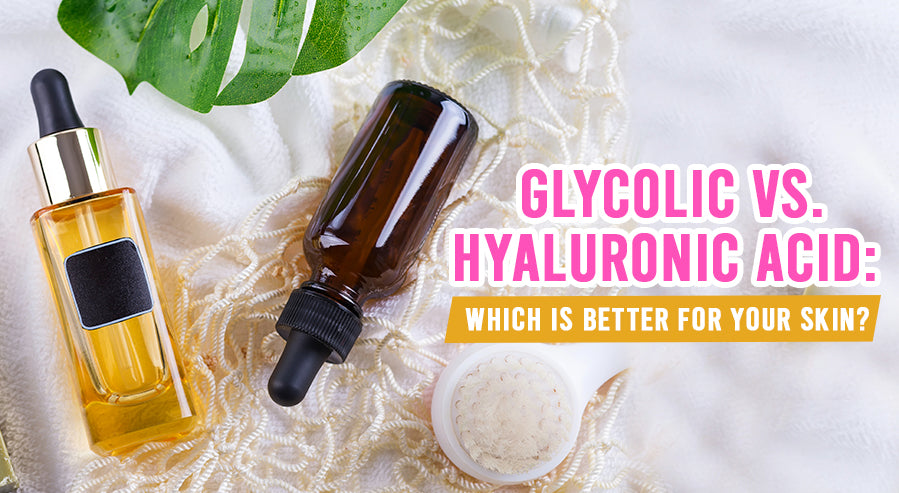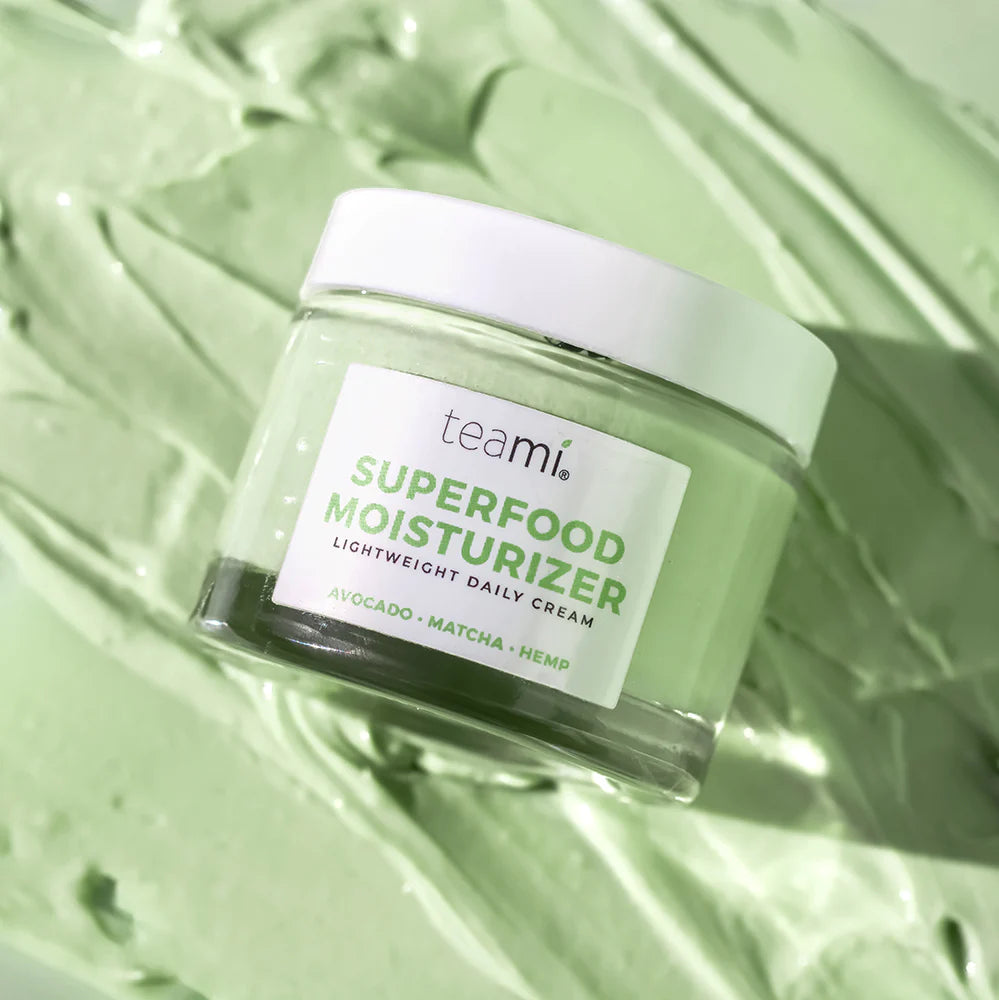Glycolic vs. Hyaluronic Acid: Which is Better for Your Skin?

Skincare has become a very popular industry and spawned countless routines and products designed to enhance our complexions. The sheer number of skincare products on the market has made it difficult to identify which products are worth the expense. Some skincare products are famous for their benefits, while others are not as well known or overlooked. Even more of these substances are useless and sold to individuals desperate to improve their skin.
Unfortunately, user reports on these products are usually anecdotal and cited more often than the actual science behind them. This has caused serious confusion about whether a product is viable and has led to questions about how certain products compare to others in the same category. This has affected well-known products for their ability to improve our skin, especially those that share terminology with their rival products.
Two common skincare compounds that can be confusing to people are glycolic and hyaluronic acid. Both acids are used in skincare, and the fact that they share a common term makes people wonder how they compare or whether one is more effective. These acids might be difficult to understand without additional context, but they have been cemented in modern skincare for various reasons.
Most people swear by one of these substances for their impact on our skin, but the details of why one is so effective over the other are fairly vague. Therefore, people who are debating either substance want to know which one is better for their skin.
What is Glycolic Acid?
Countless organic substances in our world have different effects on our bodies and skin. Some substances occur naturally in our bodies, while others can only be acquired by introducing them to other resources. Glycolic acid is a compound firmly situated in the latter camp and is not produced by our bodies. Rather, glycolic acid is a colorless, odorless solid highly soluble in water and present in several fruits.
Glycolic acid was originally coined by a French chemist named Auguste Laurent in 1848 due to his hypothesis about glycine (an amino acid). Laurent believed glycine was an amine of another acid, which he dubbed "acide glycolique" (which translates from French to glycolic acid). While Laurent first theorized glycolic acid's existence, it was not properly synthesized for another 3 years.

In 1851, a German chemist named Adolph Strecker, alongside his Russian peer Nikolai Sokolov, produced the first genuine sample of glycolic acid. This sample created a new resource for the skincare industry, though modern use of the acid was not implemented for a few more years. Nevertheless, additional methods for synthesizing glycolic acid aside from the method employed by Strecker and Sokolov were developed in the wake of their efforts.
Nowadays, several skincare products employ glycolic acid as an ingredient, making it extremely popular with people striving to improve their complexion. Glycolic acid does have applications beyond skincare, though that is the primary use for the acid in today's society. That said, not everyone understands glycolic acid's role in skincare or whether it has genuine benefits.
What Are the Benefits of Glycolic Acid?
Glycolic acid might have been discovered 175 years ago, but modern science is still catching up to its effects on the body. Modern research illuminated most information surrounding glycolic acid's effects on our body, but not everyone knows what was discovered. Most skincare products that use glycolic acid advertise the overall effects of the product or detail the alleged benefits of the acid without going into detail.
Despite that, glycolic acid has become increasingly popular in modern society and remains one of the most sought-after ingredients for skincare products. Understanding the science behind these supplements is always a good idea so you can understand what they will do for you. The science on glycolic acid is rather comprehensive now, having focused heavily on what it does to human skin. Multiple cosmetic and health benefits were discovered through modern studies, some as recent as 3 years ago.
One of the main benefits of glycolic acid is that it can be used to treat acne, a common skin issue that affects us starting from puberty. Acne causes pimples to form on our bodies that are very difficult to hide and can last a long time. Research from 1999 (almost 150 years after synthesizing it) assessed the effects of glycolic acid on acne. The study involved a peel of 70% glycolic acid on 80 female subjects with acne.
The study determined that glycolic acid improved acne in the subjects by taking advantage of its exfoliating effects. Exfoliation removes the outermost layer of skin cells and sebum, including those trapped in the pores. The downside to this benefit is that it is only available in chemical peels that are only available with prescriptions. Over-the-counter glycolic acid is not strong enough to treat acne effectively.

Another major benefit of glycolic acid is that it addresses one of the most common issues affecting our skin. From an early age, we are told to spend time in the sun because it is good for us, but sun exposure has a downside. Solar rays project ultraviolet radiation, which can cause several issues for human biology, but one of the main issues is its effect on our skin.
Overexposure to UV radiation causes photoaging, a phenomenon in which our skin ages prematurely and develops wrinkles and sunspots typically associated with advanced age. Fortunately, recent studies suggest that glycolic acid can help protect our skin from the effects of photoaging. Specifically, a 2020 study determined glycolic acid could protect the skin from sun damage, and a paper from 2018 reports that glycolic acid produces UV protection that can preemptively protect your skin from photoaging.
Finally, studies suggest that glycolic acid can reduce lines and wrinkles on the skin. These minor blemishes can produce a similar issue to photoaging and make us look older than we are. This effect was confirmed in a 2020 study where it was determined that glycolic acid could enhance other natural compounds in our skin that preserve our complexion's youthful appearance. However, hyaluronic acid remains, which has often been cited as a rival to glycolic acid.
What is Hyaluronic Acid?
Unlike glycolic acid, our bodies produce hyaluronic acid naturally to perform certain functions and preserve the integrity of our bodies. Despite being a natural component of human biology, it is a well-known substance in the skincare industry and is one of the best. Unlike glycolic acid, hyaluronic acid was discovered much later and was first obtained in 1934 from a cow's eye.
Hyaluronic acid was discovered by a German biochemist named Karl Meyer and his colleague John Meyer. In the 1970s and 1980s, the sample secured from the cow's eye was used to create a product called Healon to repair eye damage. While we were unaware of what hyaluronic acid was until Meyer and Palmer discovered it, it remains a major compound in our bodies. The human body has around 15 grams of hyaluronic acid, though a third of it is renewed daily. Despite originally being used to treat eye damage, it was later determined that hyaluronic acid could be used in the cosmetics industry.

Nowadays, hyaluronic acid is one of the most widespread and commonly used skincare products worldwide. Multiple skincare products use hyaluronic acid as one of the chief ingredients and are highly successful. Despite the success of products using hyaluronic acid, some are unaware of what makes it a vital resource to the skincare industry. Fortunately, hyaluronic acid has been extensively researched (almost more so than glycolic acid). Therefore, the benefits of hyaluronic acid can be determined by referencing the studies.
What Are the Benefits of Hyaluronic Acid?
Hyaluronic acid's benefits are better defined than glycolic acid's because it is highly compatible with human physiology. Since we naturally produce it, the biocompatibility is hardly surprising and only contributes to the acid's value in skincare. Nevertheless, you probably want more information than just the barest facts, which is understandable. Hyaluronic acid has been scientifically proven to improve skin health and prevent it from showing premature signs of aging.
The photoaging phenomenon we mentioned earlier is one of the main reasons people use hyaluronic acid: it restores the skin's natural elasticity and hydration. One of the main reasons our bodies produce hyaluronic acid is to rehydrate the skin and prevent it from drying out and cracking. UV radiation causes blemishes because it dries out the skin and removes sebum and collagen.
A study from 2014 determined that taking 120 to 240-milligram doses of hyaluronic acid for a month increased skin moisture. This had the added effect of reducing dry skin and keeping the subjects' complexions soft and supple. This also reduced wrinkles and protected the surface of the skin from photoaging. While glycolic acid has similar effects to hyaluronic acid insofar as photoaging is concerned, the latter has additional effects.

One of the main benefits of hyaluronic acid that is difficult to acquire with other substances is that hyaluronic acid has been linked to wound healing. Wounds can cause permanent blemishes if not treated properly, but hyaluronic acid can accelerate healing and reduce the risk of blemishes.
Hyaluronic acid regulates our body's inflammatory response, which causes many of the blemishes associated with injuries. Studies have demonstrated hyaluronic acid's ability to reduce the size of wounds, preventing them from encompassing and affecting large portions of our skin. This, in turn, reduces the risk of major blemishes arising due to injury or inflammation. This benefit puts hyaluronic acid slightly ahead of glycolic acid.
Which Should You Use?
While you might assume glycolic acid is superior due to its section length, several details concerning hyaluronic acid suggest it is better. Most notably, the 2020 study on glycolic acid we mentioned before indicated that it improves our skin's health by promoting certain important substances within our bodies.
One of the substances that glycolic acid enhances to produce benefits is hyaluronic acid, demonstrating that the latter is more valuable than the former. Additionally, hyaluronic acid has a wider range of benefits for the skin than glycolic acid, reinforcing its value. Therefore, the most obvious response is to use hyaluronic acid instead of glycolic acid for your skincare routine. That said, one detail worth noting could alter your decision.

It is technically possible to use hyaluronic and glycolic acid together so the latter can complement the former. While you need to know about skincare layering to perform this effectively, using them both can be very beneficial. However, if you only want to use one of them, you should opt for hyaluronic acid, given its superior range of benefits and its natural compatibility with our bodies.
Finding the Right Blend
Hyaluronic acid is a more natural fit for our bodies since we produce it naturally and need it to maintain our skin's health. While glycolic acid has benefits, hyaluronic acid is considered superior. Layering is an option, but not everyone has the time or knowledge to apply it properly, making it less appealing to beginners. Unfortunately, hyaluronic acid is not a substance that is typically used on its own and is generally combined with other substances by default. This does not diminish its effects but can make locating a quality product that provides the desired effects difficult.
We at Teami have always believed that natural substances like hyaluronic acid are more valuable for skincare than pharmaceutical-grade products. That is why we have dedicated ourselves to creating a viable catalog of natural products that can improve health and appearance. We offer a wide range of skincare products designed to improve the health and quality of your skin so you can maintain your complexion.

One of our main products is our Overnight Sleep Mask, which is made with hyaluronic acid and vitamin C (which enhances hyaluronic acid's effects). We encourage you to visit our website and try our product personally. After all, finding the right blend is a Teami effort.
Have you ever used our Overnight Sleep Mask before? If so, what were your thoughts about it? We really hope you enjoyed it as much as we do, so be sure to let us know!
Subscribe to our Newsletter
Subscribe to our newsletter and get 10% off your first purchase
 Instagram
Instagram



